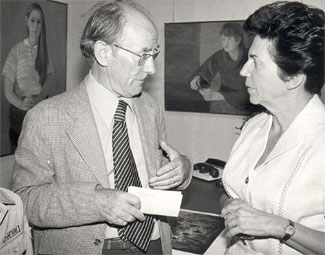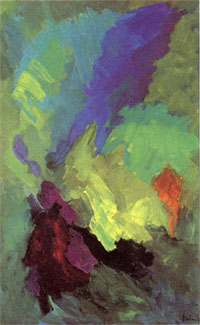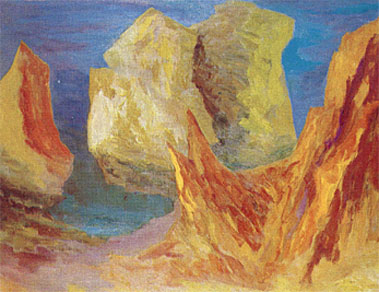|
A CRITICAL CHRONICLE ON NOÊMIA GUERRA’S PAINTING
George S. Whittet - 1987 |
| |
|
I first met Noêmia Guerra in April 1965, at the Royal College in
London.
Noêmia, around her forties, showed herself to be an active woman,
judging from her firm attitude. What most impressed one
in her countenance were her eyes, which reflected a vivid
intelligence and immediate reaction, both mental and
emotional.
Noêmia and I talked about common Brazilian friends. She also told
me she had been living in Paris, in a rented studio in
Montparnasse, since 1958.
Noêmia added that she was about to exhibit her work, in the
coming month of May, at a small gallery in London’s West
End.
|
|
 |
|
George Whittet and Noêmia Guerra |
|
|
| |
|
As I went to Paris quite frequently at the time, in order to
visit galleries, I proposed, if she was interested, that
she should take me to see her paintings that would be
exhibited in London, or at least some of her other
paintings. |
|
|
|
The opportunity arose and I was then able to see the artist’s
work in her Paris studio, and later her first exhibition
in London, in the tiny St. Martin’s Gallery, directed by a
Venetian émigré called Victor Zamattio. That exhibition
had been organized by Mrs. Raquel Braune, the Cultural
Attaché to the Brazilian Embassy, who also organized a
welcome vernissage, bringing together art critics
and personalities of London society.
In a critique on the exhibition, I wrote: “Noêmia Guerra’s oil
paintings show great vitality and spontaneity in their
composition, where the “cobalt blues and violets” suggest
the sky, through abstract references (this sky I would
soon see for myself in Brazil). The compositions, almost
abstract, suggest shapes in space by means of color and
shade modulations.
In fact, the essence of her compositions was “the movement”
produced by the variations of “shapes-tones”, suggesting
“dancing figures” to the spirit of the beholder...
It was impossible to find, in the animation of such nature, any
trace of influence of the short course given by Professor
André Lhote, which she took in 1951, when the French
professor had been invited to give a course in Pictorial
Composition at the Municipal Institute of Beaux Arts in
Rio de Janeiro, where Noêmia was studying.
|
|
|
|
The hard, well-defined contours that Lhote had borrowed from
Cézanne, and later from the cubist movement, were of no
interest to Noêmia. Color, in all its potentiality, was
the predominant factor in Noêmia’s paintings; gradually
these color modulations introduced, in her pictorial
creation, more associations in the beholder’s
understanding and spirit.
I liked Noêmia Guerra’s paintings so much that I introduced her
to Mr. Alwin Davis, a young designer who had worked in
Hollywood and had returned to London in order to start a
gallery in Mayfair. Mr. Alwin Davis and his partner, Mr.
Ronald Dongworth, agreed to include Noêmia Guerra’s
paintings in an Exhibition at the Alwin Gallery in the
following year.
1966 was an important year in Noêmia Guerra’s career. Firstly,
there was a big individual exhibition at the Jacques
Massol gallery, on the rive droite, as well as
Noêmia’s participation in the “Three Artists” exhibition
at the Alwin Gallery in London, for which I wrote a
preface. Jacques Massol invited me to write the
introduction to the catalogue for the Paris exhibition.
Below, there is an extract from that introduction. |
|
|
|
After meeting Noêmia Guerra, I visited Brazil. In the first
place, to see and comment on the São Paulo Biennial, which
allowed me to improve my knowledge, not only of Brazilian
art, but also of the social and cultural aspects of
Noêmia’s country. In particular, the landscapes, the
people, the almost surreal contrasts between wealth and
poverty, the Afro-European ethnical mixtures, the “silent”
– though always present – descendants of the Indian
tribes, an indispensable element of the racial mixture of
the Brazilian people.
This experience allowed me to better appreciate the reflections
of Noêmia’s past, already evident in her paintings.
With these impressions fresh in my retina, and the outline of the
peaks of the range called Serra dos Órgãos emerging
from the red soil, the plane was preparing to land at the
Galeão Airport in Rio de Janeiro.
I realized then that this “Tropical Brazil” was spiritually and
chromatically expressed in the tropical images of Noêmia’s
landscapes, as we can see, for example, in her penetrating
painting “Tijuca”, the urban forest situated in the
mountainous region of Rio de Janeiro. |
|
 |
|
Tijuca - 1966
Oil on canvas - 81 x 65cm |
|
|
|
|
|
In Rio, a friend accompanied me in a car and took me to visit
several characteristic places, including the Tijuca
Forest. During the outing, while I felt immersed in the
green atmosphere of the tropical forest, Noêmia’s painting
“Tijuca” came to my mind, with the colors of the forest;
it was precisely this! A dark green environment forming
the backdrop, reddish ochre contrasts of the soil, the
rhythm of the ups and downs of the hillside, suggested in
the painting by means of light green modulations, like
sunbeams shining through leaves and branches. Suddenly a
silvery shine appears amidst the somber rocks; it was a
waterfall reflecting the blue of the sky.
Once more, I felt perception as an original, creative act, thanks
to which we are simultaneously inserted in an environment
and transported to some recollection.
I went so far as no longer to consider that the merit of a
culture rests on a technical skill, but on a rumination of
a popular taste connected with the modernism of the
twentieth century. Above all, we should consider a
painting as a graphologist would, and read in the
composition the painter’s character. Art, more than ever,
is the signature of a personality.
To submit to electronic calculators and to optical abstraction is
to renounce the artist’s spiritual power. Fortunately,
there are still artists who are faithful to the rhythm of
their own magnetism. Noêmia Guerra is one of them. Her
painting radiates a luminosity that is “Painting”, this
precious substance that has recently suffered so much
devastation and constrained inventions.
As a poet, I believe that, in her landscapes and dances, Noêmia
Guerra embraces life with courageous joy, to which few
surrender themselves. As a critic, I am sure that her
message is intelligible, with no need to be decoded. It is
Painting in its pure state, with universal meaning. Less
than three months after her exhibition in Paris, Noêmia
showed eighteen paintings at the Alwin Gallery in London,
a total of forty pictures in the two exhibitions.
Durenmatt said, quite rightly, that “the artist cannot accept a
law, unless he himself has discovered it”. |
|
|
|
Progressively Noêmia discovered, in her paintings that are so
personal and euphoric, that there is no pre-conceived form
in which a mental image may boast of its materialization.
Each composition is a step taken by the artist in his
journey through a landscape of light.
Later, in 1966, I was invited to take part in a jury of European
critics at an international exhibition organized by a
small municipality in Slovenia, Sloveny-Gradec, in order
to award the prizes. I was happy to see that Noêmia
Guerra’s luminous painting – “The Cliffs of Algarve” – was
far ahead of the other Yugoslav and European paintings.
.
|
|
|
|
|
In 1967, Noêmia and her partner, Julian Luna de Prada, spent part
of the Winter in Lebanon, where they met the people in the
suks and discovered the ancient dignity in the
isolated ruins of Baalbek, which introduced new themes to
Noêmia’s compositions.
Julian and Noêmia had fun watching the arguments in the suk
marketplace: the clothing, shawls, embroidered
scarves, like flags shining under the sun rising in the
gaps between the narrow alleys.
During her trip to Lebanon, Noêmia produced numerous drawings and
watercolors for later work based on such “studies” after
returning to Paris. The trip to Lebanon and the annual
stay at Lagos, Algarve, gave Noêmia motifs for the
composition of her paintings that would be exhibited at
the Alwin Gallery in early 1968.
|
|
|
|
 |
|
Rocky Hillsides in Algarve - 1969
Oil on canvas - 120 x 154 cm |
|
Noêmia Guerra’s paintings may have different themes, but we
always see a unified approach and treatment. For Noêmia
Guerra, to paint movement is not to describe it by means
of shapes, but to create a composition that will give the
sensation of movement based on a modulation of tones.
Thus, in her compositions in which dancers, with grace and
vitality, are blended into the background of the painting,
a modulation of tones is established making a counterpoint
with other dancing image-shapes in the foreground, marking
the rhythm, by means of these “value-color” contrasts, by
the artist’s decision.
In the paintings “Rocky Hillsides" and "Algarve Coastline”, the
contrast of the “value-colors” creates a new luminosity,
with its own light rays. The artist’s alienation in
society is a contemporary cultural discomfort; but for
Noêmia, there is no alienation between the variety of the
spectacle offered by life and the warm, empathetic
response she enthusiastically transmits to the beholder.
|
|
|
|
|
During the year 1969, Noêmia had a new Exhibition at the Jacques
Massol Gallery in Paris, and at the Alwin Gallery in
London; the two exhibitions were simultaneous. They were
both noteworthy for the diversity of themes inspired by
direct personal contacts made during her trips. In my
introduction to the Alwin Gallery exhibition, I
stressed the development and maturity of an innate talent,
nurtured by experience and continuous efforts.
In the paintings inspired by the watercolors made on the spot
when she visited Brazil, Portugal and Lebanon, the human
figure is placed naturally in the landscape. I wrote in
“Le Monde” (2), “Noêmia Guerra went back to Bahia
(Brazil) in 1968. Salvador, the capital of this state, has
splendid 17th and 18th- century
baroque architecture, but Noêmia’s imagination received
greater stimulus from the people that give life to the
sun-stricken environment; the Salvador “Fish Market” is a
singular work, as it is a work of art painted with
extraordinary audacity in terms of colors and movement.
Each of the five panels is a complete painting, which may
be admired as such separately, but which even so is part
of a pictorial composition. In my view, “the hues” arouse
an exaltation, when they create a space and bring forth
“the unexpected”.
In 1973, Noêmia presented her fourth individual exhibition at the
Alwin Gallery. I wrote about her in “Pictures on
Exhibit” (New York) (3): “The Cliffs of Algarve
offer themes to Noêmia Guerra. The variations of the
motifs, which are constantly beaten by wind and waves,
reveal, thanks to a vibrant painting, a growing strength
in the composition and in the perception of tone
modulations when they depict the shapes of cliffs under
the sun”.
Four years elapsed between Noêmia’s fourth exhibition at the
Alwin Gallery and the next, at a gallery also organized by
her friend Raquel Braune.
After a very successful vernissage at the Stephen Maltz
Gallery (22 Cork St., London) in 1977, I wrote: “I found
Noêmia Guerra’s paintings even stronger and more dynamic
in the imagery and energy employed. Her main
characteristic is exuberance, with a command of one of the
most elementary expressions of the life force of any
society: dance. Noêmia’s favorite dance is that of Brazil,
her country of birth: the samba. She paints men and
women dancers, expressing their sensuality, in such a way
that the tactile quality of her painting involves the
texture and the orientation of her strokes. In some
compositions, the brush seems to follow the forms and to
caress the pigments, in a choreography that is patently
sexual. The dominant tone is red, the red of roses, of
sunsets, of ripe fruit, of wine, of blood, symbols of our
present world of violence, but kept under control by the
expression of a common joy, synthesized by the samba
music, which is a reflection of the soul of the Brazilian
people”.
In 1979, Noêmia exhibited, at the Marcel Dernhim gallery in
Paris, her most recent paintings, which demonstrated a
fantastic contrast between stability and movement. In my
critique (4) I wrote: “thanks to a constant
development towards a more expressive relation of shapes,
her “iridescent painting” projects a luminosity from
within, of a rare personal characteristic; whether the
brilliant facets are reflected in static or dynamic form,
as if animated by a breeze, a subtle modulation of light
makes all the elements of the composition move as if by
refraction”.
In the year 1981 she had another exhibition at the Marcel Dernhim
gallery. In the portraits, Noêmia Guerra took an important
step forward in relation to the previous two years,
achieving a remarkable simplicity. Knowing some of her
models in person, and the affinity between them and the
artist, I admired the honesty with which she showed them
“in two dimensions”, in a generous, audacious and
uncommitted summary.
She took part in the Brazil Festival, which was held at the
Barbican Centre in London, with three works. In my
introduction to the catalogue of this exhibition, I wrote:
“Noêmia Guerra is among the best women artists of Brazil”.
Two expressive compositions, in stunning colors, translate
a warm involvement with the life of the people, be it in
lively scenes on the beaches of Algarve or in groups of
dancers in Bahia”.
In the most recent years, Noêmia has spent the Spring and Summer
in her atelier at Lagos, Algarve, and Autumn and Winter in
her atelier in Paris.
Noêmia has become well known painting portraits, which she
considers increasingly stimulating. I shall comment on
three of the most impressive, which I was able to see in
1986, when I went to Paris in order to pose for a portrait
in Noêmia’s atelier.
The first portrait that attracted my attention was that of a
bearded young man, wearing a blue t-shirt with a drawing
in white lines on it, representing a boy that was jumping.
To my question “why this drawing?” Noêmia answered: “the
drawing is by Portinari, a picture of his son, the Maths
teacher João Portinari, who was wearing this t-shirt when
he came to visit me during one of his trips to Paris. This
drawing has become the logo of the “Portinari Project”
Institution, founded by his son João in order to preserve
the work of Cândido Portinari, an exponent of figurative
painting in Brazil, after his death in 1961.
I took delight in the expression of tenacity of the bearded man
and the subtlety of the painter Noêmia Guerra, who, though
copying Portinari’s drawing printed on the shirt, made it
one of her own creations.
The second portrait impressed me because I recognized in it the
model Maria Nunes, now a young mother, posing with her
son, an eight-month old baby called Igor. The baby’s pose
is the strangest I have ever seen in a Madonna painting –
the baby was naked and standing on his mother’s knees; I
admired the composition and the chromatic quality, in
perfect harmony with the youthfulness of the models.
The third portrait, equally noteworthy, was that of a famous
Brazilian opera singer who lives in Paris, Maria
d’Apparecida, wearing her characteristic hat. In the
background of the composition, but incorporated into its
structure, was an imaginary scene, the figure of Feliz
Labisse, discreetly modeled, himself painting a portrait
of Maria d’Apparecida. This “pictorial evocation”, as
there had been past links between the people portrayed,
reveals the imaginative way in which Noêmia treats her
composition, which is rare in modern portraits.
For Noêmia Guerra, each composition is a challenge and a stimulus
to represent her mental images, and not just a technique.
To call her an expressionist would be an inadequate cliché to
describe Noêmia Guerra’s style; in all her paintings, such
as those I have seen, one after the other, in the course
of twenty-three years, there is rather a marked
“subjectivism”, revealing her maturity in approaching the
themes, reflecting her inward personality, composed of a
generous spirit, fighting difficulties, appreciating the
forces of Nature, using all color resources, through a
personal experience and acute sensitivity.
George S. Whittet - 1987
References:
(1)
Studio International, May 1965.
(2)
Le Monde, October 30, 1969.
(3)
Pictures on Exhibit - New York, February 1973.
(4)
Art and Artists, February 1973. |
|